Mark Hunter's Blog, page 4
April 22, 2025
How to Measure the Success of a ‘Warm’ Call
Wondering if your prospecting calls are getting results? These aren’t cold calls—you’ve warmed them up a bit and now you’re hoping for progress. But what should you really be measuring?
Here are five proven ways to gauge the success of your prospecting efforts.
Do NOT Attempt a “One-Call Close.”The days of the one-call close are behind us.
If someone’s ready to buy immediately, they’re probably doing it online without ever talking to a salesperson. So don’t pressure the call into becoming a transaction. That’s not the goal.
The real success? Securing the next step. Whether it’s a second call, a demo, or just continuing the conversation, your job is to guide—not close.
You’re Able to Confirm a Time for the Next Call.One of the clearest signs of a successful call? You’ve booked another meeting.
This is what I call BAMFAM—Book A Meeting From A Meeting. If you leave a call with a scheduled follow-up, you’re moving the relationship forward.
Even if the sale is still far off, this shows interest and alignment. That next meeting is a major win.
You’re Able to Learn One Piece of Information About the Prospect.Every prospecting call should give you at least one new insight.
It could be about their business challenges, goals, or even a personal detail. Use this to add context to your follow-ups and build a stronger connection.
Mentioning that detail in your next email or call proves that you’re listening—and that builds serious trust.
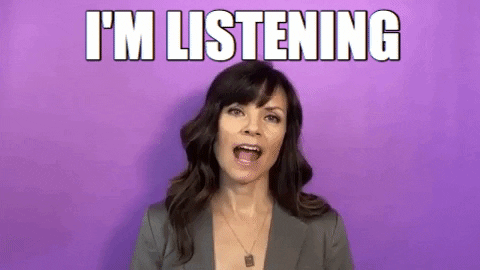 The Prospect Shares a Concern They’re Dealing With.
The Prospect Shares a Concern They’re Dealing With.When someone opens up about a real concern, that’s not just small talk—it’s a breakthrough.
It means they trust you enough to be vulnerable. And if they’re sharing something they don’t usually reveal? That’s huge.
This level of openness often signals a qualified lead—and gives you a real opportunity to show how you can help.
 Prospecting Calls Require Two Things: A Great Attitude and Patience.
Prospecting Calls Require Two Things: A Great Attitude and Patience.Mindset makes all the difference.
Go into every call with a positive attitude and a long-game perspective. Even if nothing big happens on the first call, your energy and patience can make all the difference.
Expect success. Be deliberate with your questions. And remember: progress takes time, but consistency wins.
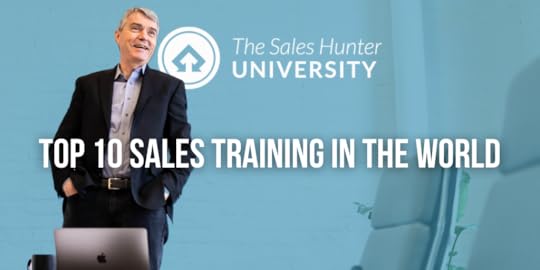
For more sales training, check out The Sales Hunter University—packed with resources to help you sell smarter, faster, and with more confidence.
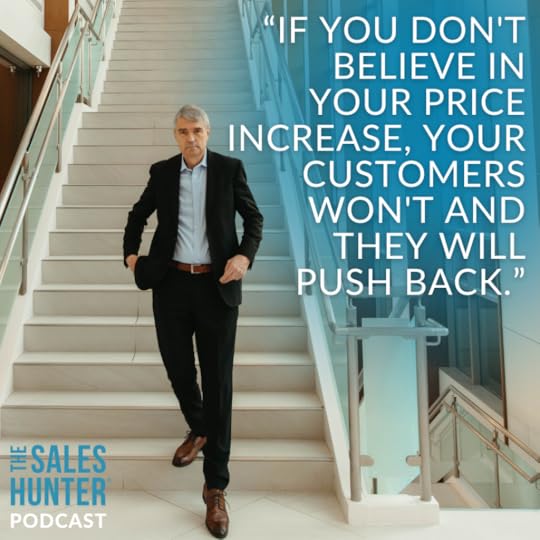 How to Keep Customers Happy While Adjusting Prices
How to Keep Customers Happy While Adjusting Prices
Mark dives into the intricate balance of market share, profit margins, and customer loyalty.
Find episode #301 wherever you download podcasts!
Mastering Optimism and Emotional Intelligence in Sales w/ Roberta MooreMark and Roberta tackle the tough challenge of handling negative customers, PLUS essential self-regulation techniques to help maintain your positive edge
Episode #302 is out now!
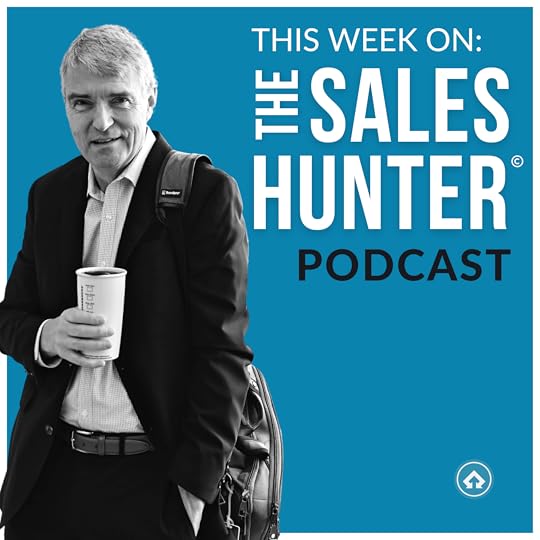
Copyright 2025, Mark Hunter “The Sales Hunter” Sales Motivation Blog. Mark Hunter is the author of A Mind for Sales and High-Profit Prospecting: Powerful Strategies to Find the Best Leads and Drive Breakthrough Sales Results.
April 15, 2025
Unleash Your Inner Sales Hunter
17 Questions to Self-Assess and Elevate Your Performance
Welcome to a deep dive into what it really means to have a sales hunter mindset. Whether you’re new to sales or a seasoned pro, these 17 questions break down each element of the mindset that separates top performers from the rest.
1. Are You Deliberate With How You Start Your Day?Top-performing sales professionals start their day with purpose. They follow a set routine that anchors their mindset and sets the tone. Rushed mornings lead to reactive days—something top sales hunters avoid at all costs.
2. Do You Set Clear Objectives Before Your Day Begins?Every successful day in sales starts with a plan. If you’re not outlining your key objectives before the day starts, you’re letting your calendar control you—not the other way around.
 3. Do You End Each Day by Updating Your CRM and Planning Tomorrow?
3. Do You End Each Day by Updating Your CRM and Planning Tomorrow?The phrase “tomorrow begins today” rings true. Wrap up your day by ensuring your CRM is up to date and your next day’s action items are locked in.
4. Do You Know Your Daily Success Metric?Top salespeople know their key metric. For me, it’s five meaningful conversations per day—with prospects, customers, or referral sources. Define yours, and track it religiously.
5. Is Your Pipeline Large Enough to Hit Your Quota?Too many sales reps don’t understand the size their pipeline needs to be. Know your close ratio and multiply your quota accordingly—usually 3.5x to 4x, minimum.
6. Is Your CRM Always Open and Working for You?Your CRM isn’t a “gotcha” tool—it’s your assistant. Keep it open, updated, and integrated into your daily workflow. Top performers treat it as mission-critical.
7. Do You Actually Follow Through on Your Follow-Up?Automated follow-ups aren’t enough. A true sales hunter personalizes, follows up intentionally, and listens. Your follow-up strategy should reflect care, not just cadence.
8. Do You Know Your Lead-to-Customer Conversion Rate?You can’t close what you didn’t properly qualify. Understanding what percentage of your leads turn into customers helps you reverse-engineer your prospecting needs.
 9. Do You Track the Number of Touches to Convert a Prospect?
9. Do You Track the Number of Touches to Convert a Prospect?From first contact to closed deal, how many touchpoints does it take? Understanding this helps you plan more effectively and close more deals with less frustration.
10. Do You Have a Real Referral Process?Referrals are sales gold—but most reps don’t work a structured referral process. Are you asking at the right moments and making it part of your regular workflow?
11. How Often Do You Give Referrals?If you want referrals, start giving them. It’s not about trading favors—it’s about creating a network of goodwill that eventually circles back to benefit you.
→ Read: 10 Ways to Get More Referrals
12. What Percentage of Your Leads Fit Your Ideal Customer Profile (ICP)?You need a clear, strict ICP filter. If a lead doesn’t meet at least 7 out of 10 of your criteria, don’t waste your time chasing it. Focus on those with real potential.
 13. Are You Actively Outbound Prospecting?
13. Are You Actively Outbound Prospecting?Inbound leads and repeat business are great, but outbound prospecting builds long-term resilience. It’s a skill you must keep sharp—because when your inbound dries up, you need to hunt.
14. How Much of Your Business Comes From Existing Customers?Knowing what portion of your revenue is recurring helps you build smarter projections. But don’t get complacent—always aim to over-deliver in new business.
15. What’s Your Process for Staying Motivated?Sales has highs and lows. Top performers smooth out the emotional roller coaster by staying focused on the process—not the results—and keeping a strong “why” front and center.
16. Do You Have an Accountability Partner or Mastermind Group?Even elite athletes have coaches. You need someone who holds you accountable—whether it’s a peer, coach, or mastermind group. It’s the #1 thing top sales pros credit for their edge.
→ Learn about the Sales Logic Mastermind and join today at this link.
17. Are You Constantly Improving Your Industry and Sales Knowledge?The best never stop learning. Stay current on your industry trends, sharpen your skills, and stay relevant. Stagnation is the enemy of a sales hunter mindset.
→Check out a course at The Sales Hunter University to sharpen your sales skills. Where do you need most help? Email Prospecting? Follow-up? Referrals? We’ve got it all.

 3 Changes to Make to Your Sales Process NOW
3 Changes to Make to Your Sales Process NOW
Mark challenges you to rethink your sales strategy by expanding your pipeline from 3.5X to a daunting 6X volume.
Find episode #299 wherever you download podcasts!
Thriving as a Salesperson in Uncertain Times w/ Mark HunterMark shares insights on how to remain a relevant and valuable resource for your customers, even amidst challenges like tariffs and supply chain disruptions.
Episode #300 is out now!

Copyright 2025, Mark Hunter “The Sales Hunter” Sales Motivation Blog. Mark Hunter is the author of A Mind for Sales and High-Profit Prospecting: Powerful Strategies to Find the Best Leads and Drive Breakthrough Sales Results.
April 8, 2025
How Long Should I Stay Engaged with a Prospect?
Engaging with prospects is a vital part of the sales process, but how long should you stay engaged? The length of prospect engagement varies depending on several factors that can significantly impact your success.
To help you optimize your prospecting strategy, here are 10 key considerations to guide your decision-making process.
1. Evaluate Prospects Based on Ideal Customer Profile (ICP)An ICP outlines the key characteristics of your best customers, such as their size, industry, and needs. If a prospect aligns with at least 70-80% of your ICP, they are more likely to be a good fit. If they don’t meet this threshold, it may be a sign to move on and focus on more promising leads.
Without a clear ICP, you’re essentially wasting time on prospects that don’t align with your ideal market.
2. Assess If Your Product Can Meet Prospect NeedsEven if a prospect fits your ICP, it’s essential to determine whether your product can meet their specific needs. There are times when a prospect may seem like a perfect fit, but their challenges or objectives may be outside the scope of what your solution offers.
In such cases, don’t hesitate to refer them to a competitor or a more suitable product. By doing so, you not only help the prospect but also enhance your reputation and possibly create new sales opportunities.
 3. Analyze Prospect Value
3. Analyze Prospect ValueWhen deciding how long to engage with a prospect, it’s important to evaluate both the immediate and long-term value they bring to your business. Some prospects may take years to close, but have enormous lifetime value once they become a customer.
On the other hand, others may offer little future potential, making it necessary to assess whether it’s worth investing time and resources. Don’t chase prospects that won’t help you achieve your broader sales objectives.
4. Determine the Length of the Sales CycleDifferent industries have different sales cycles, and it’s important to understand how long it typically takes for a prospect to make a purchase decision. Capital expenditures, budget constraints, and contract renewal timelines can all extend the sales cycle. By understanding these nuances, you can better plan your engagement and set realistic expectations for the time it will take to close a deal.
 5. Identify Downstream Revenue Potential
5. Identify Downstream Revenue PotentialIn some cases, a single sale to a prospect can open doors to significant downstream revenue. For example, if a prospect has connections to other potential clients or operates in an industry where they can influence other decision-makers, staying engaged with them may lead to multiple sales down the line.
If the downstream potential is strong, it’s worth investing more time in nurturing the relationship.
6. Evaluate Prospect’s Industry PositionHigh-profile prospects within established industries are often worth pursuing, as they can bring substantial credibility and recognition. Conversely, if a prospect is relatively unknown or has a limited industry presence, it might be worth reconsidering your engagement strategy.
However, don’t dismiss rising stars—startups and emerging companies can be highly lucrative if they show promise for future growth.
7. Explore Referral OpportunitiesOne of the best ways to extend your engagement with a prospect is by exploring referral opportunities. If a prospect has strong connections within your target industry or network, staying engaged with them could lead to valuable introductions and additional sales.
 8. Analyze Learning Opportunities
8. Analyze Learning OpportunitiesIf the prospect is developing innovative products or technologies that could help your business in the future, staying connected could provide invaluable knowledge. Plus, understanding new trends can give you a competitive edge.
9. Decide Prospect Engagement LengthUltimately, your decision on how long to stay engaged with a prospect should be based on a combination of all these factors. Use data, not emotions, to guide your approach.
While some prospects may require just a handful of interactions, others may demand a more prolonged engagement to realize their full potential. Track these metrics and adjust your approach accordingly to optimize your time and resources.
10. Create Strategic Engagement Plans for ProspectsTo efficiently manage your prospecting efforts, develop a strategic engagement plan. This plan should include a framework for evaluating prospects, determining engagement length, and setting clear expectations for follow-ups and communication. By creating a scorecard or document to assess each prospect based on the factors discussed, you’ll be able to make informed decisions about how much time and energy to invest in each relationship.
 The Mistake Salespeople Can’t Afford to Make
The Mistake Salespeople Can’t Afford to Make
In this episode, discover the ripple effects of valuing every lead and how even mismatched connections can transform into golden opportunities through referrals.
Find episode #297 wherever you download podcasts!
The Transformative Impact of Female Leadership w/ Don BardenUncover the secrets of the power of female leadership and how it will reshape the global landscape by 2028.
Episode #298 is out now!

Copyright 2025, Mark Hunter “The Sales Hunter” Sales Motivation Blog. Mark Hunter is the author of A Mind for Sales and High-Profit Prospecting: Powerful Strategies to Find the Best Leads and Drive Breakthrough Sales Results.
April 1, 2025
10 Ways to Get More Referrals
Growing your business doesn’t always have to involve complicated strategies or large investments. In fact, one of the easiest and most effective ways to increase your client base is through referrals.
In this blog, I’ll guide you through the 10 best strategies to make referrals a central part of your sales process and ultimately boost your business growth.
1. Ask After Delivering ValueThe best time to ask for a referral is immediately after you’ve delivered value to your customer. For example, after making a sale, when your customer is satisfied and happy, is the perfect moment. It’s important to make asking for referrals an automatic part of your sales process. The sooner you do it, the better.
 2. Give Referrals to Receive in Return
2. Give Referrals to Receive in ReturnIf you want to receive more referrals, be willing to offer them as well. It’s a common issue I hear from salespeople: “I don’t get enough referrals.” When I ask how many referrals they’ve given, the answer is often “none.”
The principle is simple—referrals are a two-way street. When you start giving referrals, you’ll notice that they often come back to you in unexpected ways.
3. Keep Referrers UpdatedOnce you’ve received a referral, keep your referrer updated. By doing so, you show them that their referral is appreciated, and it creates a sense of satisfaction when they see the positive outcome. Often, the person who gives you one referral is the most likely to give you another. Staying in touch is key.
4. Use Customer RecognitionCustomer success is an excellent opportunity to ask for referrals. If your client has just received an award or recognition, congratulate them! Then, casually ask if they know anyone else who might benefit from the service or product you’ve provided. This approach creates a natural segue into asking for a referral without coming off as too pushy.
 5. Request Referrals During Follow-Up Calls
5. Request Referrals During Follow-Up CallsFollow-up calls are not just about checking in on the customer; they’re an excellent time to ask for a referral. If you’re already reaching out to ensure your service is meeting their needs, use that opportunity to ask if they know anyone else who could benefit from your offering. It’s a natural way to expand your network and increase your referrals.
6. Ask for Referrals on Customer AnniversariesCustomer anniversaries—whether it’s the one-year, five-year, or ten-year mark—are perfect times to ask for referrals. This milestone often surprises your customer, and it serves as a great way to remind them of the value you’ve provided over time.
When you reach out to congratulate them, you can easily pivot to asking who else might benefit from your product or service.
 7. Leverage Year-End Reviews
7. Leverage Year-End ReviewsYear-end reviews are another perfect time to request referrals. When you’re going over the successes of the year with your client, it creates a positive environment.
As your customer reflects on the value you’ve provided, they’ll be more inclined to refer you to others, making this a prime moment to ask.
8. Use Customer SuccessIf your customer has achieved success with your product or service, don’t hesitate to congratulate them. Acknowledging their achievements and reminding them of how your business contributed to their success sets the stage for a referral request. It’s a subtle but effective way to remind them of the impact you’ve made.
9. Reach Out to Past CustomersReaching out to past customers may seem intimidating, but it can be highly rewarding. Many times, past customers are willing to refer you, or even return as clients themselves. A simple follow-up can reignite a relationship and lead to valuable referrals or business opportunities you didn’t expect.
 10. Repeat Referral Requests Consistently
10. Repeat Referral Requests ConsistentlyFinally, the most important point is to make asking for referrals a consistent part of your sales process. Over time, you’ll build a pipeline of referrals that will keep your business thriving. By weaving referrals into your regular interactions with customers, you’ll naturally grow your network and client base.
Maximize Referrals for Business GrowthReferrals are one of the most powerful tools in any salesperson’s toolkit. By consistently asking for referrals, giving them, and staying engaged with your customers, you can increase your business opportunities exponentially.

Want to learn more about maximizing referrals in your sales process?
Check out my Referrals course at Sales Hunter University to gain deeper insights and strategies for boosting your business through referrals.
Remember, it’s all about consistency. Make referrals a regular part of your routine, and watch your business grow!
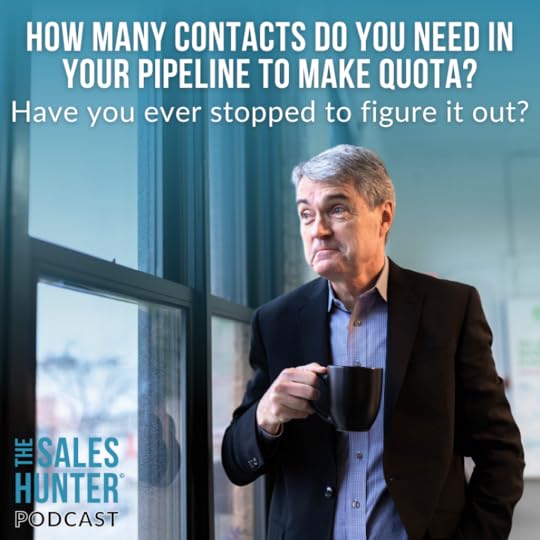 How to Find the Perfect Balance of Qualified Prospects
How to Find the Perfect Balance of Qualified Prospects
Discover the key to building a sales pipeline that truly drives success.
Find episode #295 wherever you download podcasts!
Leveraging Social Media for Sales Success w/ Brandon LeeWhat if your reputation could make or break your revenue?
Episode #296 is out now!

Copyright 2025, Mark Hunter “The Sales Hunter” Sales Motivation Blog. Mark Hunter is the author of A Mind for Sales and High-Profit Prospecting: Powerful Strategies to Find the Best Leads and Drive Breakthrough Sales Results.
March 26, 2025
Overcoming Common Barriers to Closing More Sales
Every salesperson faces obstacles and challenges to closing a sale. However, it’s not always about cutting prices or offering more; that’s just a quick fix that can hurt your long-term sustainability.
If you want to boost your sales, you need to understand customer needs, communicate clearly, and build trust. This blog post will walk through some effective strategies for overcoming barriers and closing more sales.
Discover Customer NeedsBefore trying to close a deal, take the time to understand the customer’s needs. Understanding the deeper needs of your customer will set the foundation for a successful sale. Never try to close a deal without first fully understanding the customer’s situation. Without this clarity, you risk stalling the sale.
Communicate Value Clearly to Avoid ConfusionClarity is key when communicating the value of your product or service. When discussing value, ask questions like, “How will this help you achieve your business goals?” This helps customers see the benefits from their perspective, not yours.
 Make Your Sales Proposal Specific
Make Your Sales Proposal SpecificA vague or general proposal can confuse the customer and hinder their decision-making process. The more specific your proposal, the easier it is for customers to see the value and make a decision.
Engage Decision-MakersEngage the key decision-makers early in the sales process. It’s essential that the people who will ultimately make the purchasing decision are involved and understand the proposed solution. When customers articulate the desired outcomes themselves, they’re more invested in the process and more likely to move forward with the deal.
Understand Your Customer’s CustomersEvery business interacts with multiple stakeholders, and understanding the downstream impact of your customer’s decision can significantly strengthen your position. When you show that you understand the bigger picture, it makes overcoming challenges much easier.
Adapt to Industry Changes and CompetitorsStay informed about changes in the industry and competitors. The market is always evolving, and keeping tabs on industry shifts, regulatory changes, and competitor movements is essential. Being prepared to discuss these changes with customers helps you position your solution as the best choice, even in a shifting landscape.
 Sell Solutions that Create a Competitive Advantage
Sell Solutions that Create a Competitive AdvantageFocus on selling solutions that create long-term competitive advantages. Customers are often focused on survival and competitiveness. Solutions that help customers save costs, improve efficiency, or speed up time-to-market are particularly attractive in today’s competitive business environment.
Build TrustTrust is the foundation of every successful sales relationship. It’s not enough to simply offer a solution; you must demonstrate understanding, competence, and reliability. By showing that you genuinely care about solving their problems, you foster stronger relationships that can lead to future business.
 Ensure Sales Proposals Are Clear and Understandable
Ensure Sales Proposals Are Clear and UnderstandableConfused customers don’t buy. This simple truth is especially important in today’s fast-paced world, where things are constantly changing. The clearer you make your proposals, the easier it is for customers to say “yes.”
Showcase Competency to Build ConfidenceDemonstrating competency can significantly increase customer confidence. Use testimonials, case studies, and referrals to show how your solution has worked for others. By showcasing real-life examples, you build credibility and make the decision-making process easier for the customer.
 Articulate Sales Proposals
Articulate Sales ProposalsBe able to effectively articulate your sales proposal for maximum impact. Even the best proposal can fail if you can’t communicate it clearly and confidently. If you can’t explain your proposal simply, how can you expect the customer to understand it?
Closing Sales in a Challenging MarketIn today’s challenging economic environment, closing sales is harder than ever. However, by following these strategies—understanding customer needs, communicating clearly, building trust, and articulating value—you’ll be better equipped to overcome barriers and close more deals.

To dive deeper into these strategies, check out my Prospecting course at the Sales Hunter University. Only $59!
It offers a wealth of content and practical tools to help you close more sales and navigate these challenges effectively.
 The Power of Consistent Daily Performance
The Power of Consistent Daily PerformanceIt’s time to reveal the often-overlooked secret: your Daily Performance Indicator (DPI).
Find episode #293 wherever you download podcasts!
Unleash Your Inner Sales Hunter w/ Mark HunterMark guides you through critical strategies like understanding your sales pipeline and close ratios, and the power of engaging in meaningful conversations to boost productivity.
Episode #294 is out now!

Copyright 2025, Mark Hunter “The Sales Hunter” Sales Motivation Blog. Mark Hunter is the author of A Mind for Sales and High-Profit Prospecting: Powerful Strategies to Find the Best Leads and Drive Breakthrough Sales Results.
March 18, 2025
14 Steps to Become a Top-Performing Salesperson
Becoming a top-performing salesperson doesn’t happen by accident. It takes dedication, the right mindset, and consistent effort. In this blog, we’ll break down strategies that can help elevate your sales performance and bring you closer to becoming a sales pro.
1. Your Mindset Drives Your SalesIt’s not about your product or service; it’s about how you approach sales. A positive and proactive mindset will set you apart. Understand that your actions drive success—your daily decisions matter. Take ownership of your role and your results.
2. Sales Is Not About YouSales isn’t about pushing your product or boosting your ego. It’s about solving the customer’s problem. Successful salespeople know that the focus should always be on the customer. They listen carefully, understand the customer’s needs, and tailor their approach accordingly.
3. Top-Performers Are Goal-FocusedIt’s essential to stay focused on both long-term and short-term goals. While many salespeople focus on yearly or quarterly targets, top performers break down their objectives into daily performance indicators (DPIs). They measure progress based on the activities they need to complete each day, rather than simply hitting a big milestone.
4. What Are the Outcomes Your Customers Receive?Customers aren’t just buying products—they’re buying results. To close deals, top salespeople focus on the outcome the customer is trying to achieve. They understand that when customers see a clear result from their purchase, they’re more likely to be satisfied and refer others.
5. You Control the DayTop performers take control of their schedule. They don’t let the day dictate what gets done. They set clear objectives and make sure they’re met. While customers are important, you shouldn’t let their needs control your entire day. Prioritize your tasks and manage your time effectively to ensure success.
6. Work Your Focus and Discipline MusclesDiscipline is key to success. Start your day with a routine that sets you up for productivity and focus. This will help you stay on track and avoid distractions. Successful salespeople don’t let the chaos of the day knock them off course. Focus and discipline go hand in hand.
7. Activate Your Sales Muscle MemoryJust like a muscle, your sales skills need regular exercise. Prospecting is a critical part of your daily routine. If you skip prospecting for a while, it will feel awkward when you return to it. Top salespeople prospect consistently to keep their sales skills sharp and natural.
8. Listen to UnderstandEffective communication is more than just talking—it’s listening with intent. Salespeople who excel listen to understand their customers’ needs. They don’t just hear words; they interpret the meaning behind them. This allows them to ask the right questions and deliver more accurate solutions.
9. Commit to Providing SolutionsTop salespeople don’t sell products—they offer solutions. They focus on helping customers find the best answer to their problems. Whether it’s through a product, service, or combination, the goal is to solve a problem, not just make a sale. When you help customers achieve their desired outcome, you build trust and loyalty.
10. Continuous Learning to Become an SMETop-performing salespeople never stop learning. Whether it’s through podcasts, books, or videos, they actively seek out new knowledge to stay ahead. They invest time each week to expand their expertise in their industry and their craft. Being a subject matter expert makes you more valuable to your customers and boosts your credibility.
11. Who’s on Your Sales Success Team?Surround yourself with like-minded individuals who challenge and support you. Sales is not a solitary endeavor. Having a strong network of peers who encourage each other can help elevate everyone’s performance.
As Jim Rohn famously said, “You are the average of the five people you spend the most time with.” Build a group of people who help you grow.
12. A Rising Tide Lifts All BoatsIf I can be in an organization, if I can be part of a team—these may not be people who you work with, they may be people from other sales companies, or other endeavors. But it’s amazing how, when you all challenge yourself, what happens is you lift each other up and a rising tide lifts all boats.
→ Learn more about the Sales Logic Mastermind led by Mark Hunter and Meridith Elliot Powell.
13. Optimists Play the Long GameTop salespeople are optimists. They understand that there will be ups and downs, but they’re in it for the long haul. The best performers don’t let a rough day or week knock them off course. They focus on the bigger picture and know that persistence pays off.
14. Believe in Yourself and Your PotentialPerhaps the most important trait of a top-performing salesperson is self-belief. If you don’t believe in yourself, how can you expect customers to believe in you? Trust in your ability to help others achieve what they didn’t think was possible. This confidence will shine through in every interaction and build rapport with your customers.

If you’re serious about improving your sales game, check out Mark Hunter’s Roadmap to Success: Top-Performing Salespeople course at Sales Hunter University.
It’s packed with valuable insights and practical tips to help you excel. Also, don’t forget to listen to the Sales Hunter Podcast and Sales Logic podcast for more advice and inspiration.
Take control of your sales career today and start implementing these strategies to unlock your potential!
 15 Proven Strategies for Selling in Tough Times
15 Proven Strategies for Selling in Tough Times
Can you really thrive in a volatile market?
Enhance your sales performance even when the economy is working against you.
Find episode #291 wherever you download podcasts!
The Future of Sales with AI-Powered Tools w/ Terry BrockWe uncover how AI tools like Perplexity can transform the way we gather and interpret customer sentiments from social media platforms.
Episode #292 is out now!

Copyright 2025, Mark Hunter “The Sales Hunter” Sales Motivation Blog. Mark Hunter is the author of A Mind for Sales and High-Profit Prospecting: Powerful Strategies to Find the Best Leads and Drive Breakthrough Sales Results.
March 11, 2025
Identify Your Ideal Customer: Answer These 7 Questions
If you don’t know who your ideal customer is, you’re wasting time and resources.
Here are 7 critical questions that will help you not only find your ideal customer, but also make sure you’re effectively selling to them.
https://youtu.be/jj9gbuV0KQs1. What’s the value you create?Before you can find your ideal customer, you need to understand the value you provide. What problems do you solve for your customers? If you can’t clearly define the value you bring, your customers won’t see it either.
Clearly communicate the benefits of your product or service, focusing on how it helps customers achieve their goals or solve their problems.
2. Who buys from you now?Review your current customer base. Who are the people buying from you? Understand the core value you’ve provided them, not just the product they purchased.
Customers are looking for solutions, not just products. If you understand what outcome they seek, you can better identify and target those who will benefit from your offering.
3. Who is your Perfect Customer?Look deeper into your current customer list. Who is your “perfect customer”? Identify patterns in terms of role, industry, location, and other key characteristics. The more specific you can be, the better you’ll target future customers.
There are more ideal customers out there than you think — you just need to know how to find them.
4. Why do your customers buy from you?→ I can help you identify the profile of your ideal customer. Check out my Ideal Customer Profile Masterclass here.
Why did your customers choose you over the competition? Did they buy from you because of your unique offering, customer service, or something else?
Understanding the “why” behind a customer’s decision is crucial for tailoring your messaging and sales approach. This insight can help you pinpoint the exact factors that resonate with your target audience. Reach out to existing customers and ask them what influenced their decision to buy from you.
 5. What industries do your best customers operate in?
5. What industries do your best customers operate in?In today’s market, customers are more informed than ever. To sell effectively, you need to become an expert in the industries your best customers operate in. This helps you speak their language, understand their pain points, and provide targeted solutions.
Focus on industries where your best customers are, and build expertise in those areas to become the go-to salesperson.
6. Where can you find 50 more Perfect Customers?Once you understand your ideal customer, where can you find 50 more? A strong lead generation strategy is crucial. Ensure your messaging is aligned to attract similar prospects and keep a steady flow of high-quality leads.
Without a strong lead pipeline, your sales efforts will fall short.
 7. Describe the attributes of your perfect customer?
7. Describe the attributes of your perfect customer?Can you describe your ideal customer in a few sentences or bullet points? If not, refine your customer profile. Be specific about their demographics, job titles, challenges, and industry.
The clearer you are about who your perfect customer is, the better you’ll be at targeting the right leads.
Take Action and Know Your Ideal CustomerKnowing your ideal customer is essential for sales success. By following these seven steps, you can focus your efforts on the right prospects and drive business growth.
If you want more detailed guidance, check out Sales Hunter University, where Mark Hunter walks you through how to identify and score your ideal customer.

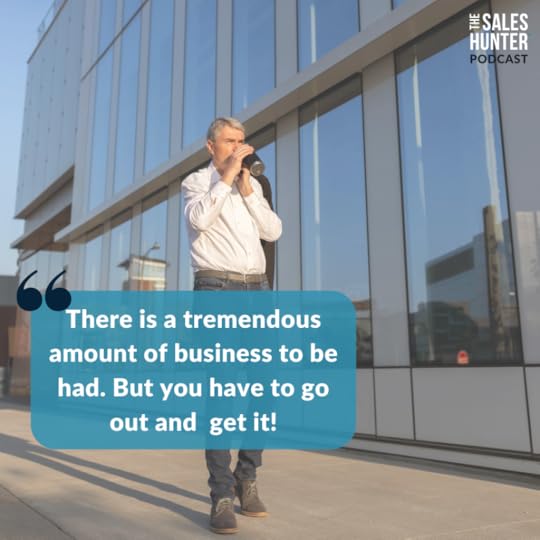 Strategic Selling Through Tough Times
Strategic Selling Through Tough TimesLearn how to turn challenges into opportunities
and why doubling down on your industry knowledge can set you apart as the go-to expert.
Find episode #289 wherever you download podcasts!
Evolving from Lone Wolf to Collaborative Sales Success w/ Meridith Elliott PowellBuilding Your Community for Success
Elevate your sales performance and enhance various aspects of life, including health, relationships, and finance.
Episode #290 is out now!

Copyright 2025, Mark Hunter “The Sales Hunter” Sales Motivation Blog. Mark Hunter is the author of A Mind for Sales and High-Profit Prospecting: Powerful Strategies to Find the Best Leads and Drive Breakthrough Sales Results.
March 4, 2025
How to Sell in a Slow Market
In today’s competitive sales world, selling in a slow market can be a daunting challenge. If you’re feeling stuck, you’re not alone!
Many sales professionals are finding it difficult to keep momentum when the market is slow. Fear not! Here I’ll share five proven strategies to help you thrive in slower times and keep the sales pipeline flowing.
1. Don’t Take Your Foot Off the GasIt’s tempting to slow down when it seems like there’s no business to be had, but this is a mistake. When you ease off, it’s incredibly difficult to get back on track. Sales momentum is key, even in slow times.
Instead of taking a break, focus on consistent, daily activities. This includes making a higher volume of phone calls, sending more targeted emails, and having more meaningful conversations with potential customers. This approach keeps you active in your market and builds opportunities that you might not see immediately. Remember, activity is your lifeblood in a slow market.
 2. Simplify Your Offerings
2. Simplify Your OfferingsWhen markets are slow, confusion is your enemy. Buyers are more cautious and are only willing to purchase when it feels absolutely necessary. To make it easier for your prospects to say “yes,” you need to simplify your offer.
One powerful strategy is to scale down your product or service offerings. By offering a smaller version of what you sell, you make it easier for customers to take that first step in doing business with you. Once they are engaged, you can sell them up to a bigger version or additional services over time. This approach establishes the relationship and sets you up for future sales.
3. Align Your Value Proposition with Customer PainIn slow markets, customers are often hesitant to make decisions unless they feel significant pain or urgency. This is why it’s crucial to align your value proposition with the specific challenges your customers are facing. Only when you’ve clearly identified their pain points should you put an offer on the table.
You’ll want to use thoughtful questioning to get your prospects to open up about their needs. Find a balance between being patient and moving quickly enough to create urgency. For example, I don’t push my customers to buy immediately, but I do make it easy for them to take action by providing the right tools—like a registration link—without any pressure.
4. Use Stories to Build TrustBuilding trust in a slow market is critical, and one of the most effective ways to do that is by using storytelling. Share customer success stories that demonstrate how your product or service has helped others, particularly those with similar challenges.

By sharing stories, you humanize your brand and help prospects see themselves in the situation of the satisfied customer. Think of it like reading restaurant reviews before you try a new place—you want to know what other people have experienced before you make a decision.
5. Focus on Existing and Lost CustomersIn slow markets, it’s crucial to focus your efforts not just on new leads, but also on your existing customers and those who have previously chosen not to buy from you. These two groups are often the easiest to engage with, because you already have a relationship with them.
Selling in a slow market isn’t easy, but with the right mindset and strategies, you can navigate these challenging times and emerge successful.
Stay focused, stay patient, and keep pushing forward. With persistence, you can sell your way through any slow market.
 How Master Your DayProven Time Management Strategies
How Master Your DayProven Time Management Strategies How top performers take control of their day to achieve success in sales.
Find episode #287 wherever you download podcasts!
Rethinking Sales Dynamics with AI and Cryptocurrency w/ William GilchristThis conversation explores how businesses are integrating AI into their sales operations, enhancing productivity and expanding market reach.
Episode #288 is out now!

Copyright 2025, Mark Hunter “The Sales Hunter” Sales Motivation Blog. Mark Hunter is the author of A Mind for Sales and High-Profit Prospecting: Powerful Strategies to Find the Best Leads and Drive Breakthrough Sales Results.
February 25, 2025
The 3 Fastest Ways to Generate Business
Unlock the Power of Your Existing Relationships
When it comes to generating business, too many salespeople overcomplicate things. They get caught up in the idea of needing fancy tools, systems, and resources. But the truth is, you have far more opportunities right at your fingertips than you realize.
You’ve already put in the work to build these relationships. Now it’s time to leverage them and reap the rewards.
I’ll walk you through simple, actionable strategies that will help you generate more business quickly. Best part? You don’t need to reinvent the wheel.
1. Leverage the Power of Existing Customers
Your existing customers are one of the most underutilized assets in your sales arsenal. Here’s how you can tap into this goldmine to generate more business:
Sell More to Existing Customers: Your current customers are already familiar with your products and services. As they grow, so can your relationship with them. Continuously look for opportunities to expand your business with them.Introduce New Products and Services: If your company has launched new items or services, now’s the time to introduce them to your existing customers. Don’t assume they know everything you offer. Many salespeople miss the opportunity to promote new solutions to customers they’ve worked with for years.
Tap into Their Network: Existing customers are a great gateway to new leads. They likely know other divisions, departments, or professionals who could benefit from what you offer. Ask for introductions—these referrals are often the easiest leads to convert.Read: When Is the Best Time to Ask for a Referral?
Ask for Referrals: Your current customers appreciate the value you bring. Don’t hesitate to ask them for referrals. The trust they have in you is an incredible asset that can lead to new business.Read: How to Ask for a Referral
2. Reconnect with Old Customers

What about customers you haven’t heard from in years? It’s easy to forget about them, but many salespeople are shocked by how much business can be generated from their past clients. Here’s why you should revisit old relationships:
Reach Out to Lapsed Customers: When was the last time you reached out to customers who haven’t purchased from you in a while? You’ll be amazed at the opportunities that open up when you reconnect. Your old clients may be ready to buy again, or even better, they may know someone who needs your products.Same Strategies Apply: The strategies that work with existing customers also apply to old customers. Ask them about their current needs and introduce them to new offerings. Rebuild that relationship, and find out how you can serve them again.
3. Don’t Forget About Customers Who Didn’t Buy

We’ve all experienced rejection at some point. But just because a customer didn’t buy from you the first time doesn’t mean they won’t buy from you in the future. Here’s why you should circle back to those who turned you down:
Revisit Past Prospects: Take a deep dive into your CRM and identify all the customers who didn’t buy from you. Reach out to them and ask how things are going. Circumstances may have changed, and they might be more open to your solution now.Stop Chasing New Leads – Look Within!
Here’s the big takeaway: there are far more leads available to you than you think. Rather than constantly chasing new prospects, start by looking inside your own customer base. Existing clients, old customers, and prospects who didn’t buy from you before are all rich sources of potential business.
 Harnessing Collective Wisdomfor Sales Growth!
Harnessing Collective Wisdomfor Sales Growth!Mastermind groups aren’t just about learning from others; they’re about mutual coaching and support.
Find episode #285 wherever you download podcasts!
Unleashing the Power of Referrals and Networkingw/ Larry Long Jr.How to make ‘deposits’ so you can leverage business relationships and make ‘withdrawals’ later.
Episode #286 is out now!

Copyright 2025, Mark Hunter “The Sales Hunter” Sales Motivation Blog. Mark Hunter is the author of A Mind for Sales and High-Profit Prospecting: Powerful Strategies to Find the Best Leads and Drive Breakthrough Sales Results.
February 18, 2025
Why You Need a Mastermind
What does it take to be successful in sales? One crucial factor is being part of a mastermind group. Joining a mastermind group elevates your skills and talents because it connects you with high-performing peers.
Not convinced yet? Read these ten reasons.
1. AccountabilityYou need peer support! A mastermind group connects you with like-minded professionals who will hold you accountable—not your boss or significant other. These peers push you to meet goals and stay focused, ensuring you remain on track.
2. ReferralsAs you connect with top-performing salespeople, you’ll naturally find opportunities to collaborate. The power of mutual referrals is invaluable in growing your business and expanding your network.
Read How to Create a Referral Network.
3. Crisis ControlSales can be chaotic. When things spiral out of control, a mastermind group helps you regain focus and navigate crises. Having a trusted circle to bounce ideas off and get advice during tough times is a game-changer.
4. Learning ResourceMastermind groups are rich learning environments. Everyone brings unique knowledge and experiences to the table, making it a perfect place for collaborative learning. Sharing ideas and strategies with others accelerates growth and keeps you ahead of the curve.
5. Emotional SupportSales can feel like an emotional rollercoaster. A mastermind group provides emotional support when you’re feeling low or celebrating victories. It’s a place where you can lift each other up and share in each other’s successes and challenges.
6. Idea BouncerBefore jumping into new projects or ideas, you can use your mastermind group as a sounding board. Sharing concepts with others who understand your business helps you gauge whether your idea is solid or just a fleeting thought.
7. ShortcutsLearn from the experience of others. A mastermind group is the perfect place to discover shortcuts that can save you time and effort. With the rise of AI tools and techniques, your peers can guide you on how to leverage the best tools for sales, helping you stay ahead of the competition.
8. Long-Term StabilitySales is a journey with many highs and lows. A mastermind group helps maintain long-term stability by offering consistent emotional support and rational guidance. This stability allows you to stay focused on your goals and avoid burnout.
9. Rational ThinkingGain clarity in times of stress.
Sales often triggers emotional reactions. When emotions run high, having a group of rational thinkers can help you regain perspective. Members of your mastermind group know you well and can offer sound advice to calm you down and bring logic back into the situation.
10. ConfidentialityA mastermind group provides a safe space to share your ideas, goals, and dreams without fear of judgment. It’s a supportive environment where you can open up and explore new possibilities with others who have your best interests at heart.
If you’re not already part of a mastermind group, consider joining the SalesLogic Mastermind. I co-host the SalesLogic Podcast with Meredith Elliott Powell, where we’ve created a space for sales professionals to connect, learn, and grow together. Visit SalesLogicPodcast.com to join our Mastermind and experience these 10 benefits firsthand.
 Building Strong Client Relationships with
C-A-R-T
Building Strong Client Relationships with
C-A-R-TElevate your sales game with the C-A-R-T framework—Confidence, Authenticity, Risk, and Trust.
Find episode #283 wherever you download podcasts!
Tech Sales and Enterprise Sales Strategy w/ Chris Bussing+Mastering Sales Call Openers!
Chris shares his wealth of experience from the tech industry, particularly in cloud services, highlighting the importance of finding an opener that aligns with your personality.
Episode #284 is out now!

Copyright 2025, Mark Hunter “The Sales Hunter” Sales Motivation Blog. Mark Hunter is the author of A Mind for Sales and High-Profit Prospecting: Powerful Strategies to Find the Best Leads and Drive Breakthrough Sales Results.
Mark Hunter's Blog
- Mark Hunter's profile
- 25 followers



